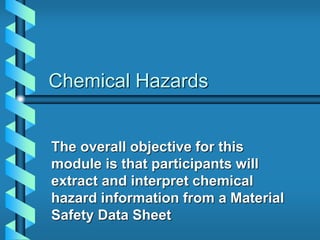
Chemical Hazards from Material Safety Data Sheet
- 1. Chemical Hazards The overall objective for this module is that participants will extract and interpret chemical hazard information from a Material Safety Data Sheet
- 2. Overview Chemical terms and definitions that will help you when handling chemicals General properties of common chemicals and how to handle them appropriately How to use the Material Safety Data Sheet to find information about a chemical
- 3. Expectations Identify three types of organic hydrocarbons Identify the three major hazards associated with organic compounds List the three main types of inorganic chemicals Identify the major hazard associated with inorganic chemicals Identify the two chemical types indicated on the pH scale Identify a corrosive material based on the OSHA definition Use the Material Safety Data Sheet to find information about a chemical
- 5. Periodic Table of the Elements
- 6. Chemical Symbols Calcium Ca Carbon C Oxygen O Combine to form Calcium Carbonate CaCO3 A Chemical Compound!
- 7. Two Major Chemical Groups Organic Inorganic
- 8. Organic Chemicals Based on the chemistry of carbon Hydrocarbons are the root of most organic chemicals
- 9. Organic Chemicals Aromatic Hydrocarbons • Benzene, toluene, xylene, and naphthalene Halogenated Hydrocarbons • Freon, CFC’S, and PCB’S Phosphorylated Hydrocarbons • Organophosphates Oxygenated Hydrocarbons • Aldehydes, ketones, and carboxylic acids
- 10. Hazards of Organic Chemicals Most are flammable • Characteristics such as flashpoints lower and upper flammability and autoignition temperatures should be known Most are anesthetics • They should always be used in well-ventilated spaces Some are carcinogens • Toxicity limits should be known and appropriate personal protective equipment worn
- 11. Inorganic Chemicals Acids Bases Salts cleaner
- 12. 0 1 2 3 4 5 6 7 8 9 10 11 12 13 14 Acid Base Neutral Increasing strength ( H ) Increasing strength (OH ) + _ pH Scale pH Scale
- 13. Identifying Acids Acids have a pH less than 7 High concentration of H+ ions Turn litmus paper red Taste tart React with metals to form hydrogen gas
- 14. Identifying Bases Bases have a pH greater than 7 Low concentration of H+ ions Turn litmus paper blue Taste bitter Have a slippery, soapy feel
- 15. Identifying Salts Salts are one or more metal ions combined with one or more nonmetal ions Formed when an acid and base react with one another May be toxic and contain heavy metals
- 16. Hazard of Inorganic Chemicals Corrosive • The second most commonly used and transported group of hazardous materials. • “Any liquid that has a severe corrosion rate on steel”.
- 17. Hazard of Inorganic Chemicals Corrosive OSHA Definition: • “A chemical that causes visible destruction of, or irreversible alterations in, living tissue by chemical action at the site of contact.”
- 18. Properties of Chemicals Physical properties - Can be measured Chemical properties - How a chemical will react
- 19. Physical Properties Volatility Boiling point Vapor pressure • Measure of pressure that a gas/vapor will exert on the inside of a closed container • Measured in mm of mercury or inches of mercury • As temperatures rise the vapor pressure increases
- 20. Physical Properties Evaporation rate Melting / Freezing point Specific gravity • Water = 1 • Less than one is less dense and will float in water • More than one is more dense and will sink in water
- 21. Physical Properties Vapor Density • When the gases and vapors are compared to normal room air (air = 1) • Any gas or vapor that has a number less than one is less dense and will rise in air • Any gas or vapor that has a number larger than one is more dense and will sink in air Solubility Chemical Compatibility
- 22. Physical Properties pH • It is a scale • Low and high numbers are corrosive Flashpoint • Minimum temperature at which a substance gives off vapor sufficient to form an ignitable mixture with air
- 23. Physical Properties Flammable - Flashpoint below 1410 F Combustible - Flashpoint above 1410 F and below 2000 F Ignitable - Flashpoint less than 1410 F
- 24. Physical Properties Lower Flammable Limit (LFL or LEL) and Upper Flammable Limit (UFL or UEL) • Are the range of chemical vapor to air ratio that needs to exist before a chemical will ignite
- 25. Physical Properties Lower Flammable Limit • Lowest concentration, by volume in air, which will explode, ignite, or burn when there is an ignition source Upper Flammable Limit • Maximum concentration, by volume in air, which will explode, ignite, or burn when there is an ignition source
- 26. Fires Three elements necessary for a fire to occur: • Oxidizer (promote burning) • Fuel (something to burn) • Ignition source
- 27. Chemical Properties Oxidizers Pyrophoric Water reactive
- 28. Oxidizers Chemicals that contain oxygen and will give it up readily May cause or enhance the combustion of other materials
- 29. Pyrophoric Solids and liquids spontaneously ignite in air at certain temperatures
- 30. Water Reactive Chemicals become spontaneously flammable or give off flammable or toxic gas when in contact with water
- 31. Chemical References Material Safety Data Sheets The Chemical Dictionary Product Label Farm Chemical Handbook Poison Control Center
- 32. Material Safety Data Sheets (MSDS) OSHA Requirements • Identity • Physical and Chemical Characteristics • Physical Hazards • Health Hazards • Routes of Entry • PEL and TLV
- 33. OSHA Requirements • Carcinogenicity • Precautions for Safe Handling and Use • Control Measures • Emergency and First Aid Procedures • Date of Preparation • Name, Address, Phone Number of Prepare Material Safety Data Sheets (MSDS)
- 34. Understanding types of chemicals, properties, potential hazards, and use of reference materials will enable you to handle chemicals safely and appropriately